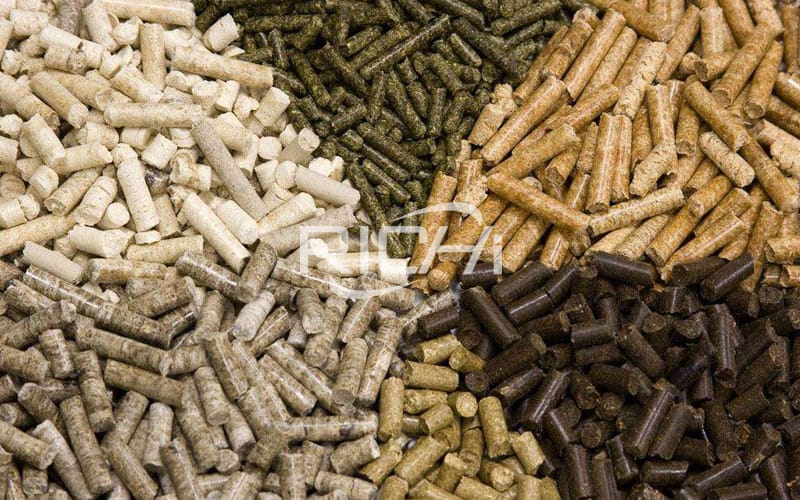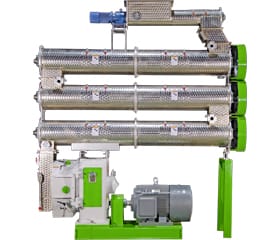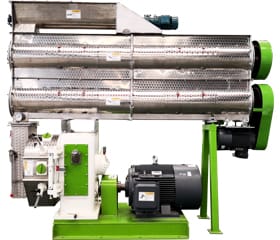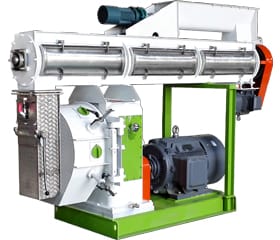Principles and formula design methods of poultry feed
For aquaculture production, a single feed cannot meet the nutritional needs of animals. Production practice has proved that only through the scientific collocation of various feed ingredients can we obtain compound feed with sufficient nutrients, balanced nutrition and good palatability.
The compound feed for poultry is composed of a variety of feed materials in proportion to the nutritional needs and feeding characteristics of the poultry. The determined mix ratio of various feed materials is the feed formula for poultry. To design the formula of poultry compound feed, it is necessary to study the nutritional principles of poultry, determine the nutritional requirements of poultry (feeding standards); study the characteristics of poultry feed ingredients, determine the nutritional value of various feeds; also consider the status and price of feed resources And the possibility of stable production. The purpose of poultry feed formulation design is to rationally select raw materials with good nutrition and low cost, and scientifically produce high-quality compound feed, so as to carry out breeding production and obtain maximum economic benefits.

1. Basic principles and parameters to be mastered in poultry feed preparation
(1) Principles of poultry feed preparation When preparing poultry feed, the following 3 principles must be followed:
① The standards must be adjusted appropriately based on the nutritional requirements standards of poultry, combined with the production response in practice, that is, the feeding standards should be used flexibly;
② In addition to considering the amount of feed nutrients, the palatability of the feed ingredients used must also be considered, and a feed with complete nutrition and good palatability must be prepared as much as possible;
③) The selection of feed ingredients must consider the principle of economic accounting, that is, try to adapt to local conditions and choose suitable and low-cost feed ingredients.
(2) Basic parameters to be mastered for poultry feed preparation
To prepare a poultry feed with a scientific basis, in addition to following the above principles and referring to multiple influencing factors, three basic parameters must be mastered:
① The corresponding nutritional requirements of different breeds of poultry;
②The nutrient content of the selected feed;
③Market price of feed ingredients.
2. Manual design method of poultry feed formula
Commonly used methods for manual design include trial and error method, square method and algebra method. Although the square method is simple and easy to implement, it can only meet the calculation of one nutritional requirement indicator (such as crude protein), and cannot consider multiple nutritional requirement indicators. The algebraic method is based on the square method to set up equations for different nutritional requirements (such as energy, crude protein, etc.), and then form a simultaneous equation set to solve various feed dosages that meet all nutritional requirements. The most commonly used manual design method in production is the trial-and-error method. This method is easy to master and can be used by general production units to design feed formulations. It can be roughly divided into 6 steps.
①Determine the breeding standards of poultry. According to the breeds of poultry being raised and the selection of feeding standards at the stage of production, the types and quantities of various nutrients such as energy that should be given to the feed to be formulated are determined.
②According to the local feed resources and own experience, the types of feed ingredients and the proportion of trial mixes are preliminarily drawn up.
③) Find out the nutrient content of the selected feed ingredients from the "Feed Nutrition and Nutritional Value Table".
④ Calculate the content of each nutrient component in the selected raw materials according to the trial mix ratio, and add them item by item to calculate the content of each nutrient component in the finished product, and then compare it with the feeding standard determined in ① Compare and adjust to a level basically consistent with it.
⑤ Use appropriate additives, such as amino acids, vitamins, minerals, antibiotics, etc., according to the feeding standards, prevention of animal diseases and growth promotion.
⑥Calculate the cost of compound feed and print out the poultry feed production formula.

3.Poultry animal feed making raw materials
Poultry animal feed making raw materials are broadly classified into cereal grains, protein meals, fats and oils, minerals, feed additives, and miscellaneous raw materials, such as roots and tubers. These will be discussed in separate headings below. More information on measuring the nutrient composition of ingredients and the process of formulating poultry feeds is available in the section on poultry feed formulation.
The term "cereal gains" here includes cereal grains, cereal by-products, and distillers dried grains with solubles. Cereal grains are used mainly to satisfy the energy requirement of poultry. The dominant feed grain is corn, although different grains are used in various countries and regions of the world. Of course, in reality, a poultry feed pellet manufacturer will use any grain in a poultry diet if it is available at a reasonable price. Although the amounts and types of cereal grains included in poultry diets will depend largely on their current costs relative to their nutritive values, care must be taken to avoid making large changes to the cereal component of diets. As sudden changes can cause digestive upsets that may reduce productivity and predispose the poultry to disease.
Protein is provided from both vegetable and animal sources, such as oilseed meals, legumes and abattoir and fish processing by-products.
(1)Vegetable protein sources:
Vegetable protein sources usually come as meal or cake, the by-product of oilseed crops. The main oilseed crops include soybean, rapeseed/canola, sunflower, palm kernel, copra, linseed peanut, and sesame seed. After the oil is extracted, the remaining residue is used as feed ingredient. Oilseed meals make up 20-30% of a poultry diet. Inclusion levels do vary among formulations for different species and for the same species in different regions.
(2)Animal protein sources:
The main animal protein sources used in poultry diets are meat meal, meat and bone meal, fish meal, poultry by-product meal, blood meal, and feather meal. Although the production of animal protein for human consumption has been under continual pressure and marred by much controversy, the world-wide and domestic consumption of animal protein continues to grow and much of the future supply of meat protein will come from poultry. With increased animal protein production there will be increased demand for feed and, in particular, a demand for ingredients high in protein and energy.
(3)Fats and Oils
Fats and oils, collectedly termed lipids, are regularly used in poultry feed pellets to satisfy the energy need of the animal as lipids have more than twice compared with carbohydrates or proteins per kg weight. Lipids are also an important carrier for fat-soluble vitamins as wells for the provision of essential fatty acid, linoleic acid, in the diet. A variety of fats and oils are used in feed, including lipids of animal origins and lipids of vegetable origin. In practical feed formulation, the level of lipids rarely exceeds 4% in compound feed. However, even a small decrease in digestibility can cost dearly in terms of dietary energy. Like any other nutrient, a varying proportion of lipids are undigested depending on their sources and the species and age of the animal to which they are fed.
(4)Minerals and Vitamins
Minerals are vital for normal growth and development in poultry, such as bone formation and body processes such as enzyme activation. Some minerals such as calcium and phosphorus are required in large quantities. For example, laying hens require between 3.5-4% calcium, 0.3-0.4% available phosphorus, and 0.2% sodium in their diets for egg production. Other minerals, such as copper, iron, manganese, zinc, selenium, cobalt, iodine, and molybdenum, are required in milligram quantities but deficiency of these minerals will lead to serious health problems in mild cases and death in severe cases.
Similarly, vitamins are essential for the body systems of poultry. Both fat-soluble (A, D, E, K) and water-soluble (biotin, choline, folic acid, niacin, riboflavin, thiamine, pyridoxine, pantothenic acid) are needed in the diet to maintain proper health and wellbeing of poultry.
Some vitamins and minerals are provided by most ingredients but the requirements for vitamins and minerals are generally met through premixes added to the diet. Diets may also contain additives for specific purposes. These are discussed in more detail in the section on feed additives.
【Related info about poultry feed】
1.How to make chicken mash feed in poultry feedstuff powder feed processing unit line?
3.Precautions for poultry chicken farm construction
5.Small scale 1 ton per hour broiler poultry chicken feed pellet making plant machine for sale
6.Turn-key customizable easy to use poultry chicken livestock cattle pig feed plant to meet your needs
7.Analysis of 3 tph poultry chicken feed pellet mill large vibration,big noise and operation abnormity
9.1-10 Ton per hour poultry chicken cattle feed production line's crushing ingredient process
10.Large poultry cattle feed mill factory euqipmens' installation and maintenance
If you want to built one complete pellet production line in your country, pls send the inquiry to us. We will customized design according to your requirement.



